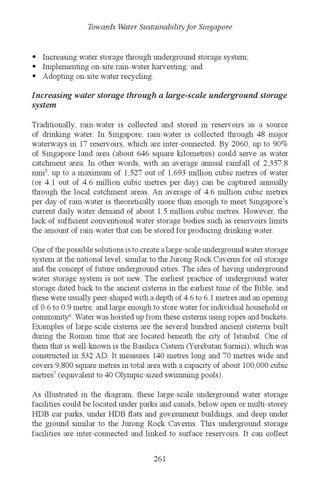Towards Water Sustainability for Singapore • Increasing water storage through underground storage system; • Implementing on-site rain-water harvesting; and • Adopting on-site water recycling.
Increasing water storage through a large-scale underground storage system Traditionally, rain-water is collected and stored in reservoirs as a source of drinking water. In Singapore, rain-water is collected through 48 major waterways in 17 reservoirs, which are inter-connected. By 2060, up to 90% of Singapore land area (about 646 square kilometres) could serve as water catchment area. In other words, with an average annual rainfall of 2,357.8 mm5, up to a maximum of 1,527 out of 1,693 million cubic metres of water (or 4.1 out of 4.6 million cubic metres per day) can be captured annually through the local catchment areas. An average of 4.6 million cubic metres per day of rain-water is theoretically more than enough to meet Singapore’s current daily water demand of about 1.5 million cubic metres. However, the lack of sufficient conventional water storage bodies such as reservoirs limits the amount of rain-water that can be stored for producing drinking water. One of the possible solutions is to create a large-scale underground water storage system at the national level, similar to the Jurong Rock Caverns for oil storage and the concept of future underground cities. The idea of having underground water storage system is not new. The earliest practice of underground water storage dated back to the ancient cisterns in the earliest time of the Bible, and these were usually peer-shaped with a depth of 4.6 to 6.1 metres and an opening of 0.6 to 0.9 metre, and large enough to store water for individual household or community6. Water was hoisted up from these cisterns using ropes and buckets. Examples of large-scale cisterns are the several hundred ancient cisterns built during the Roman time that are located beneath the city of Istanbul. One of them that is well-known is the Basilica Cistern (Yerebatan Sarnici), which was constructed in 532 AD. It measures 140 metres long and 70 metres wide and covers 9,800 square metres in total area with a capacity of about 100,000 cubic metres7 (equivalent to 40 Olympic-sized swimming pools). As illustrated in the diagram, these large-scale underground water storage facilities could be located under parks and canals, below open or multi-storey HDB car parks, under HDB flats and government buildings, and deep under the ground similar to the Jurong Rock Caverns. This underground storage facilities are inter-connected and linked to surface reservoirs. It can collect 261
